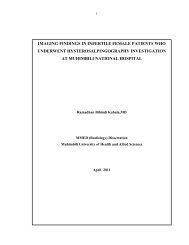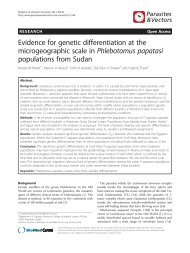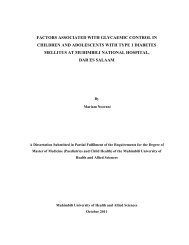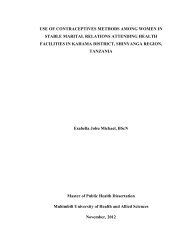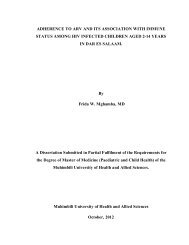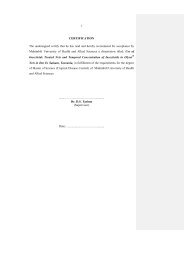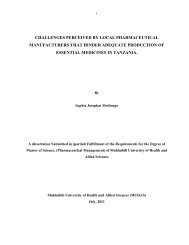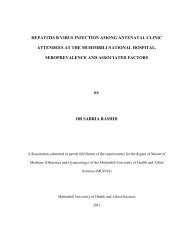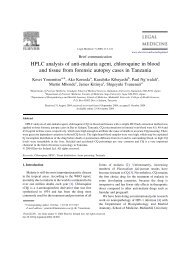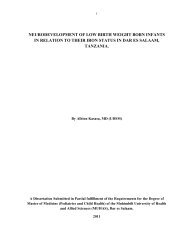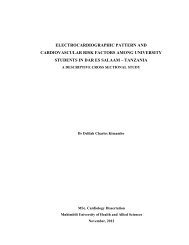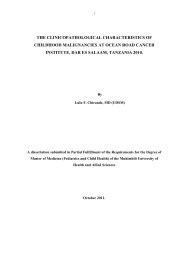DISSERTATION WORK MSAFIRI KABULWA.pdf
DISSERTATION WORK MSAFIRI KABULWA.pdf
DISSERTATION WORK MSAFIRI KABULWA.pdf
Create successful ePaper yourself
Turn your PDF publications into a flip-book with our unique Google optimized e-Paper software.
3<br />
2. LITERATURE REVIEW<br />
2.1: Global perspectives of tobacco use<br />
Prevalence of different forms of tobacco use<br />
Jha and colleagues analyzed sex-specific smoking prevalence data from studies conducted in<br />
139 countries worldwide. Results showed that 20% of adolescents aged 15 -19 years old were<br />
current tobacco smokers in year 2000 (Jha et al 2002) while Nitcher et al (1997) reported a<br />
prevalence of 30% among girls in the United States, in Russia the prevalence was 55.5% and<br />
26.9% among males and females respectively (Stickley and Carson 2009). The prevalence of<br />
lifetime smoking cigarettes and tobacco chewing among young adults in France was 65.9% and<br />
11% respectively (Slama et al 2009). El-Roueiheb et al (2008) reported a prevalence of those<br />
who ever smoked to be 37.8% and current smokers to be 11.4% among high school students in<br />
Lebanon.<br />
A study on use of smokeless tobacco (dipping tobacco snuff/chewing tobacco) conducted in<br />
Manipur India among the 13-15 years old reported a prevalence of 10.6% in 2001 (WHO/TFI<br />
2003). Among individuals aged more than fifteen years old rural residents in India the<br />
prevalence of using smokeless tobacco were 17.5% (Daniel et al 2008). The reported<br />
prevalence of tobacco chewing among students in United States and India was 39% and 32.9%<br />
respectively (Salehi and Elder 1995, Joshi et al 2010). In Bangladesh the prevalence of tobacco<br />
chewing among adults was reported to be 20.6% (Flora et al 2009).<br />
Knowledge on adverse effects of tobacco use on general health<br />
Several researchers have reported different levels of knowledge on adverse effects of tobacco<br />
use on general health which ranged from 46.5% to 98.2% for lung cancer and 49.3% to 94%<br />
for heart diseases (Terrades et al 2009, Siahpush et al 2006, Rikard-Bell et al 2003, Jensen and<br />
Overgaard 1993). In their study among dental patients who attended 27 dental practices in<br />
Northern Ireland, Terrades and colleagues assessed the awareness of patients about the<br />
consequences of smoking on their general and oral health. The results indicated high<br />
knowledge on smoking as cause of lung cancer (98.2%) and heart diseases (92.3%). Similar<br />
results were reported by Siahpush et al (2006) whereby the proportion of respondents who were



